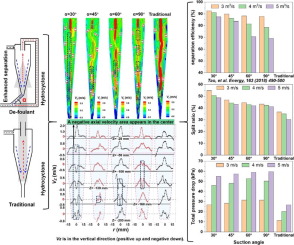Separation and Purification Technology ( IF 8.1 ) Pub Date : 2020-01-13 , DOI: 10.1016/j.seppur.2020.116555 Tao Song , Jinyi Tian , Long Ni , Chao Shen , Yang Yao

|
Hydrocyclone has been extensively used in various separation processes. For example, in the sewage source heat pump system, a De-Foulant Hydrocyclone with Reflux Ejector (DFHRE) can fully use the kinetic energy of its overflow to suck its underflow and flush away the foulants flowing out with the underflow. Our previous experiments in 2018 showed that the reflux ejector could prevent the underflow orifice from blocking, and reducing the suction angle could increase the separation efficiency by approximately 10% whereas decreasing its energy consumption markedly. To date, however, its mechanism is still unclear. Therefore, in this study, we used the Particle Image Velocimetry (PIV) method to study the flow field in DFHREs with different suction angles and compared it with that in the traditional hydrocyclone without reflux ejector. Results indicated that, in all the tested DFHREs, there was a negative-axial-velocity area in the center of hydrocyclones, which was not found in the center of the tested traditional hydrocyclone. The negative axial velocity produced by the overflow-suck-underflow decreased with increasing suction angle whereas increased with increasing inlet velocity. The split ratio and total pressure drop of the DFHRE are respectively and approximately 18.5% and 28.3 kPa greater than those of the traditional hydrocyclones at the suction angle of 30°. This proved that the experimental performance of the sewage suction ejector used in hydrocyclone, that is, the suction effect of the reflux ejector and the separation efficiency of DFHRE were the best at the suction angle of 30°. Besides, the obtained change of flow field caused by the reflux ejector provided a new idea for enhancing hydrocyclone separation.
中文翻译:

粒子图像测速技术在带回流喷射器的污垢水力旋流器中流场的实验研究
水力旋流器已广泛用于各种分离过程中。例如,在污水源热泵系统中,带有回流喷射器的污垢水力旋流器(DFHRE)可以充分利用其溢流的动能来吸引其底流并冲走随底流流出的污垢。我们在2018年的先前实验表明,回流喷射器可以防止底流孔堵塞,减小吸角可以将分离效率提高约10%,同时显着降低能耗。然而,迄今为止,其机制仍不清楚。因此,在这项研究中,我们使用粒子图像测速(PIV)方法研究了具有不同吸角的DFHRE中的流场,并将其与没有回流喷射器的传统水力旋流器进行了比较。结果表明,在所有测试的DFHRE中,在水力旋流器的中心都有一个负轴速度区域,在测试的传统水力旋流器的中心没有发现。上吸下溢产生的负轴向速度随吸力角的增加而减小,而随入口速度的增加而增加。在吸入角为30°时,DFHRE的分流比和总压降分别比传统水力旋流器高约18.5%和28.3 kPa。这证明了用于水力旋流器的污水吸水喷射器的实验性能,即回流喷射器的吸水效果和DFHRE的分离效率在吸水角为30°时最佳。除了,











































 京公网安备 11010802027423号
京公网安备 11010802027423号